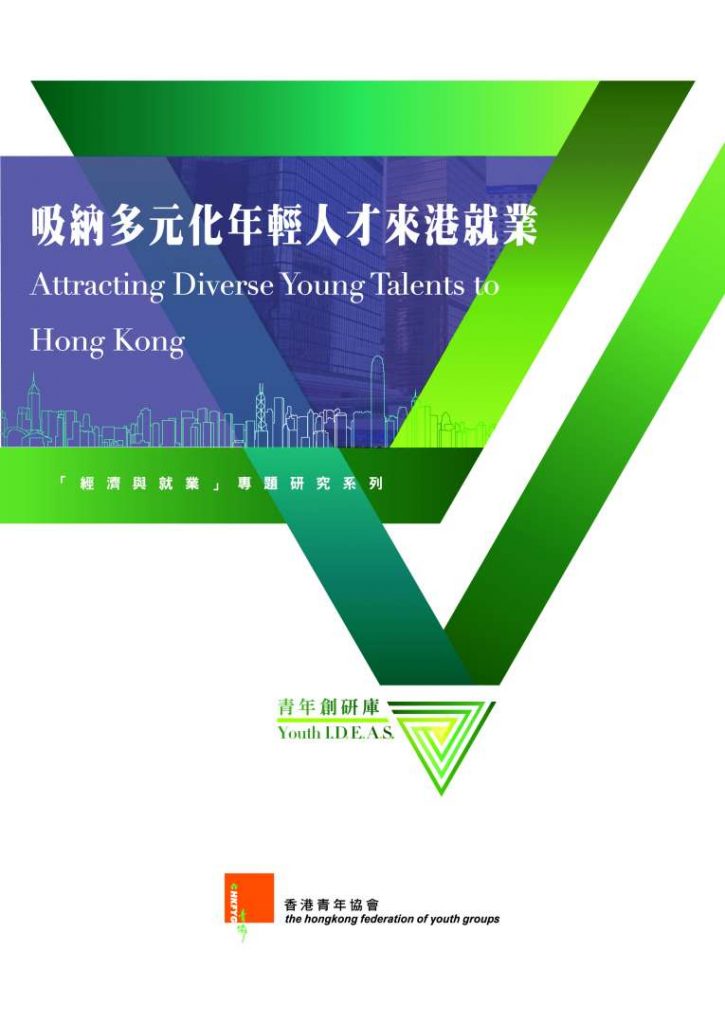Attracting Diverse Young Talents to Hong Kong
Youth I.D.E.A.S. 43
Employment and Economics Development
Attracting Diverse Young Talents to Hong Kong
27 June, 2019
 The Census and Statistics Department has estimated that the overall labour force participation rate in Hong Kong will decrease gradually from 59.2% in 2016 to 49.6% in 2066.[1] This figure reflects the fact that the labour force is gradually shrinking due to an aging population, a trend that may hinder Hong Kong’s overall economic development. Consequently, in its previous reports, the Employment and Economic Development Group of the Youth I.D.E.A.S. has discussed the issue of encouraging young-old people’s and women’s employment as a means of alleviating the problem of a shrinking labour force.
The Census and Statistics Department has estimated that the overall labour force participation rate in Hong Kong will decrease gradually from 59.2% in 2016 to 49.6% in 2066.[1] This figure reflects the fact that the labour force is gradually shrinking due to an aging population, a trend that may hinder Hong Kong’s overall economic development. Consequently, in its previous reports, the Employment and Economic Development Group of the Youth I.D.E.A.S. has discussed the issue of encouraging young-old people’s and women’s employment as a means of alleviating the problem of a shrinking labour force.
In addition to unleashing the potential of the labour force and enhancing the quality of local talents, attracting more diverse young talents to Hong Kong is another possible policy solution.
The clustering of high-quality talents is significant to the economy of developed regions across the globe. The IMD World Talent Ranking 2018[2] released by the Institute for Management Development in Switzerland and The Global Talent Competitiveness Index 2019[3] released by INSEAD Business School, The Adecco Group and the Tata Communications both showed that Switzerland ranks first in the clustering of talents in the world, while Singapore ranks first in Asia. The percentage of foreign talents account for 31.1%[4] and 5.1%[5] in their labour forces, respectively. These figures reflect the way in which rich talent resources in Switzerland and Singapore are related to their ample and high-quality foreign talents, which contribute significantly to the countries’ high valued-added economies. In Hong Kong, although the attitude to outside talents[6] is open, they account for only 1.67%[7] of the total labour force, which is relatively low.
However, the issue of attracting additional young talents to work in Hong Kong is controversial. Some people worry that it may affect local employment opportunities. Others think that attracting diverse outside talents could supplement the workforce of industries with talent shortages, as well as open up broader economic opportunities for Hong Kong.
At present, Hong Kong employers can apply for work visas for outside talents via various talent admission schemes. Outside talents who are interested in Hong Kong may also apply via these schemes. In total, 66,176 talents[8] were approved to work in Hong Kong in 2018. This figure is not high.
It is worth exploring whether or not Hong Kong should carry out further action to attract young talents, the type of talents that should be attracted and the concrete measures that need to be carried out. Meanwhile, the employment opportunities of local youths should be taken care of, in addition to alleviating the problem of the shrinking labour force and diversifying the economic development of Hong Kong.
This study attempts to understand the above problems by making reference to the experience of Singapore and Switzerland in regard to policy. It also looks at the views and experiences of and difficulties encountered by young outside talents in regard to working in Hong Kong, as well as the views of employers and scholars, in order to review the strengths and weaknesses of Hong Kong in attracting young outside talents. An attempt is made to give concrete recommendations regarding the issue of attracting young talents.
Data were collected from April to June 2019 using three methods: case interviews with 21 outside talents aged 18-39 years; interviews with five experts and scholars; and relevant policy information in regard to attracting talents in Hong Kong, Singapore and Switzerland.
Discussion
- A rich and high-quality talent pool is significant to the economy of regions lacking in natural resources. However, the future labour force of Hong Kong will gradually shrink due to aging and low birth rates, which is disadvantageous to the region’s overall economic development. The population policy report of The Hong Kong SAR Government has stated that attracting additional outside talents is one of the possible solutions to this problem.
- Whether or not Hong Kong should further attract talents is a controversial issue. Hong Kong should take an approach to dealing with the problem of the shrinking labour force that encompasses multiple strategies, including enhancing the quality of local talents and unleashing the potential labour force. It should also consider carefully further attracting young outside talents as one of the ways to maintain economic development and open up diverse economic opportunities.
- The attitudes of Hong Kong, Singapore and Switzerland toward outside talents are all open, but Hong Kong is much less capable of attracting talents than Singapore and Switzerland. It is believed that this situation is due to the extremely relaxed immigration and residency policies of Switzerland, as well as the better quality of life in Singapore and Switzerland than in Hong Kong. Besides, Singapore has set up an agency specifically responsible for attracting talents. In contrast, Hong Kong has not adopted any pro-active strategies or incentives to attract high-quality talents in areas in which there are labour shortages.
- The attraction of Hong Kong to outside talents includes the region’s overall international image, a liberal environment, an excellent social order, high standards of living, good career development opportunities, an open and equal workplace environment, a good geographic location, and the connection between Hong Kong and those who have studied there. These prevailing factors should be maintained and enhanced by Hong Kong.
- The specific obstacles to outside young talents working in Hong Kong:5.1 The high cost of rent and expensive living expenses have deterred interested talents from coming to Hong Kong, especially those with families.
5.2 Foreign talents who have no connection to and are not familiar with Hong Kong may not be interested in Hong Kong.
5.3 Some outside talents worry that the international image and the liberal environment of Hong Kong cannot be maintained, which may reduce their willingness to stay in Hong Kong.
5.4 Language barriers and difficulties integrating into the local community affect the long-term staying decisions of some talents.
Recommendations
- Set up a “ConnectHK” agency responsible for the overall coordination of publicity and recruitment in regard to talents.
- Encourage enterprises with talent shortages to launch international internship programs.
- Tertiary education institutions should diversify their sources of recruiting international students. They can also provide incentives in order to attract more exchange students from the international world.
- Provide housing allowances to high-quality outside young talents, as well as to those talents who are in short supply in Hong Kong, for a duration of 12 months.
- Provide orientation to outside young talents and build up supportive networks, such as mutual aid groups, for them.
[1] Census and Statistics Department. (2017). Hong Kong labour force projections for 2017 to 2066. Hong Kong: Census and Statistics Department.
[2] IMD. (2018). IMD World talent ranking 2018. Switzerland: IMD.
[3] Lanvin, B. & Monteiro, F. (Eds.) (2019). The global talent competitiveness index. France: INSEAD, the Adecco Group, and Tata Communications.
[4] Source: Swiss Federal Statistical Office. (2019). Statistical data on Switzerland 2019. Retrieved from https://www.bfs.admin.ch/bfs/en/home/news/whats-new.assetdetail.7767426.html
[5] Source: Singapore Ministry of Manpower webpage. Retrieved 21 March 2019 from http://www.mom.gov.sg/documents-and-publications/foreign-workforce-numbers
[6] “Outside talents” in this report is referred to the talents from the mainland China and foreign countries while “foreign talents” is referred to the talents from foreign countries.
[7] Please refer to Chapter 3 of this report for information about the calculation method used.
[8] Please refer to Chapter 3 of this report.




